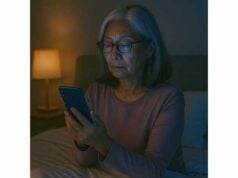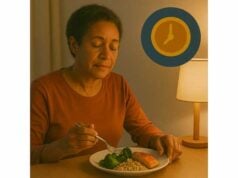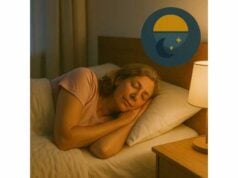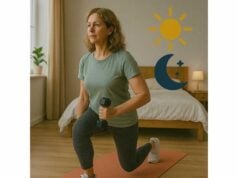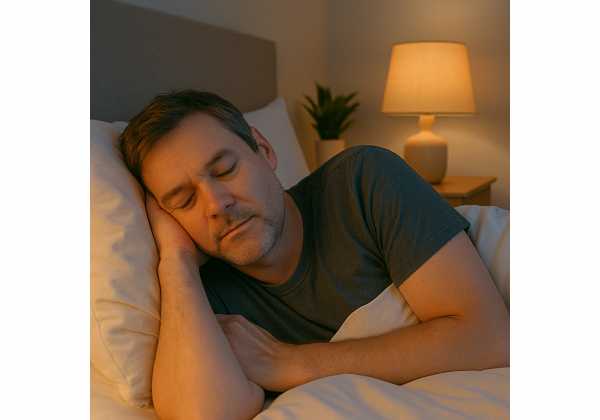
How many hours should you sleep to protect healthspan—not just today’s energy, but decades of cognitive and cardiovascular resilience? Most adults do best near seven hours per night, but the right number depends on age, biology, and schedule. Sleep needs shift across the lifespan, and both short and long sleep can signal trouble. This guide explains what “optimal” looks like, how to measure real sleep time (not just time in bed), when to adjust your sleep window, how to nap without harming the night, and which red flags mean it is time to call a clinician. For broader context on how sleep interacts with stress and recovery systems, see our overview of sleep, stress, and recovery strategies. Use this article as a practical map: determine your target, test it at home, and refine it with simple experiments that fit your life.
Table of Contents
- The U Shaped Curve: Short, Long, and Optimal Sleep
- Individual Differences: Chronotype, Age, and Activity
- How to Measure Sleep Time Accurately at Home
- When and How to Adjust Your Sleep Window
- Napping Without Harming Night Sleep
- Red Flags: Persistent Daytime Sleepiness or Microsleeps
- When to Seek Medical Advice About Sleep Duration
The U Shaped Curve: Short, Long, and Optimal Sleep
Across large cohorts, self-reported sleep duration and long-term risk form a U-shaped curve. People who routinely sleep very little (for example, ≤5–6 hours) show higher rates of cardiovascular events, diabetes, obesity, depression, and early mortality. At the other extreme, routinely sleeping ≥9 hours also associates with higher risk. The lowest risk in many datasets clusters around 7 hours per night, give or take about an hour for individual biology. While these are population averages rather than prescriptions, they offer a useful starting point.
Why would both ends associate with harm? On the short side, sleep restriction drives sympathetic activation, worsens glucose control, elevates inflammatory tone, and compresses slow-wave and REM sleep that your brain and heart rely on. Chronic restriction also invites errors—especially when driving—and undermines mood and impulse control. On the long side, very high sleep duration often reflects something else: untreated sleep disorders (apnea, limb movements), untreated depression, chronic pain or illness, or fragmented night sleep that forces morning “catch-ups.” In other words, long sleep can be a marker, not a cause.
Three practical principles help you use the U-curve wisely:
- Aim for a personal middle. Start with a 7-hour target (time asleep, not time in bed). If you wake refreshed, remain alert in the afternoon without extra caffeine, and maintain stable mood and blood pressure, you are likely close to your sweet spot.
- Favor consistency over perfection. A stable schedule matters as much as the mean. Wide swings (sleeping 5 hours on weekdays and 9 on weekends) stress your circadian timing and feel like weekly jet lag.
- Treat “long sleep” as a clue. If you always need 9–10 hours and still feel foggy, look for hidden causes: snoring or pauses in breathing, restless legs, chronic pain, late-night alcohol, or fragmented sleep due to light/noise.
It is also normal for needs to flex with life load. Heavy training, intense cognitive work, early caregiving, or travel may add 30–60 minutes temporarily. Likewise, after a few short nights, a recovery night often stretches by an hour. Track how you feel across the week, not just one morning. The goal is durable performance and stable mood, not hitting a number.
Individual Differences: Chronotype, Age, and Activity
Not everyone thrives at exactly seven hours. Chronotype (your preferred timing), age, hormones, and daily load all shape your ideal sleep dose. Understanding these differences lets you adjust targets and expectations without second-guessing every fluctuation.
Chronotype (lark vs. owl)
Your internal clock sets windows when sleep comes easily and runs deepest. Early types tend to wind down sooner and wake earlier; late types sleep better with later bedtimes and wake times. For both, sleep quality is highest when bedtime aligns with the internal “sleep gate”—roughly in the hours after melatonin rises and core temperature starts to fall. Forcing sleep too early or too late reduces deep sleep and invites awakenings, which makes seven hours feel like six.
Age
- Young adults (20s–30s): Many do well near 7–8 hours. Social and screen factors often push bedtimes later than physiology prefers, shrinking total sleep on work nights.
- Midlife (40s–60s): Deep sleep gradually declines. Needs may stay similar, but continuity matters more—fragmentation steals restorative value. Menopause and andropause can shift timing and raise arousal; hot flashes, night sweats, and snoring may appear.
- Older adults (70+): Sleep becomes lighter with more early awakenings. Aiming for 7 hours may still be right, but it may be split (longer wake after sleep onset or brief afternoon naps). Long nights in bed often backfire: low sleep pressure leads to more clock-watching.
Activity load and training
Heavy endurance or strength blocks increase sleep need by 30–90 minutes for many athletes. So do periods of sustained cognitive work (exams, complex projects). Instead of chasing a moving target, set a base (for example, 7:15) and flex upward during peaks, then return to baseline.
Biology and modifiers
- Caffeine half-life extends with age and varies genetically; late caffeine can shorten deep sleep even when you “fall asleep fine.”
- Alcohol near bedtime fragments sleep and suppresses REM, making a 7-hour night feel like 6 hours of quality.
- Medications (sedatives, some antidepressants, beta-blockers) can change architecture or timing.
- Comorbidities (pain, reflux, nasal congestion) reduce continuity; fixing them often reduces “needed” hours because the hours count for more.
If you are actively reshaping timing, a quick primer on circadian tools—morning light, evening dimming, and consistent anchors—can help you shift without losing sleep. For practical steps, see guidance on resetting your body clock.
How to Measure Sleep Time Accurately at Home
Most people confuse time in bed (TIB) with total sleep time (TST). The difference is your sleep efficiency, and it matters. Eight hours in bed with six-and-a-half hours asleep is not the same as seven hours asleep. To calibrate your true needs, measure cleanly for two weeks.
Start with a simple log
Write down:
- Lights-out time and final wake time.
- Estimated minutes to fall asleep (sleep latency).
- Number of awakenings longer than ~2 minutes and total minutes awake after sleep onset (WASO).
- Midday sleepiness (1–9 scale) and afternoon energy.
- Any naps (start, end, and how you felt after).
Use a wearable as a helper, not a judge
Consumer devices estimate TST reasonably well at the weekly trend level, but stage breakdowns (deep, REM) are approximate. Treat device estimates as directional. Focus on:
- TST weekly average and consistency.
- Sleep efficiency (TST ÷ TIB). Aim for ≥85%.
- Variability in bed and wake times (keep within ~60 minutes).
Cross-check with reality checks
- Morning cognition: how quickly you can retrieve names or start focused work.
- Reaction time (simple phone app 1–2 times weekly). Slower times often flag sleep debt.
- Mood (brief 3-item check: calm/tense, positive/negative, energized/fatigued).
Avoid common measurement traps
- Over-weighting a single bad night. Look at 10–14 days.
- Assuming early wakings always mean insomnia. If you wake refreshed at 05:45 after sleeping 7:15, that may be your natural schedule.
- Taking device “sleep scores” as gospel. The score aggregates many inputs; emphasize how you function.
What if your device shows 6:20 but you feel great?
Some people are true “short sleepers,” but this is rare. More often, the device underestimates sleep or you’re riding short-term adrenaline. Try adding 15–30 minutes earlier for a week and see if energy and patience improve. If nothing changes, you may be close to your personal set point.
If you plan to lean on tech for longer experiments, this overview of what to track and what to ignore helps you focus on metrics that inform decisions, not just generate anxiety.
When and How to Adjust Your Sleep Window
Think of your sleep as a window you can slide and size. If mornings feel groggy, afternoons slump, or you need weekend “catch-up,” it is time to test a change. Use a two-week protocol: adjust, hold steady, evaluate.
Step 1: Decide whether to shift timing or size
- Timing problem signs: You fall asleep late despite fatigue; wake too early; or feel “second wind” at night.
- Size problem signs: You fall asleep quickly, wake to the alarm feeling unrefreshed, and rally only after caffeine—most days.
Step 2: Make a focused change
- For timing: Move lights-out and wake time by 15 minutes every 2–3 days until you hit a schedule you can maintain seven days a week. Combine with morning outdoor light (10–30 minutes) and evening dimming. Limit late caffeine, heavy meals, and bright screens.
- For size: Add or subtract 15 minutes of time in bed. Hold for a week and monitor TST, sleep efficiency, and afternoon sleepiness. If efficiency dips below ~85% with more time, you may be “over-windowed.” If efficiency rises and you feel sharper, keep it.
Step 3: Guard anchors
- Wake time is your strongest anchor. Choose a realistic time and stick to it even after a rough night; use an early afternoon nap (10–20 minutes) if needed rather than sleeping in.
- If you must stay up late, protect the following 1–2 nights by trimming evening load and skipping alcohol.
Step 4: Troubleshoot common obstacles
- Can’t fall asleep earlier? Add morning light and a brisk morning or midday walk. Keep the last hour pre-bed quiet and dim.
- Can’t stay asleep? Check room temperature (16–19 °C), reduce evening alcohol, move dinner earlier, and address pain or reflux.
- Wide weekday/weekend gap? Compress weekend drift to ≤60 minutes. If social life runs late, start wind-down earlier and plan a brief next-day nap.
If persistent insomnia patterns (long sleep latency, frequent awakenings, early morning wake) are blocking your progress, a brief program of stimulus control and sleep scheduling can reset the system. See a practical approach to CBT-I techniques you can implement.
Napping Without Harming Night Sleep
Naps are tools—powerful when used sparingly and precisely. The aim is to restore afternoon alertness without eroding the night’s homeostatic sleep pressure.
When naps help
- After a short or fragmented night.
- Before a sustained attention task (long drive, exam, precision work).
- During circadian dips (early to mid-afternoon), especially for early chronotypes.
Best practice parameters
- Duration: 10–20 minutes. Set a 25-minute timer (accounting for a few minutes to fall asleep). This limits sleep inertia and preserves night pressure.
- Timing: End by ~15:00–15:30 for most schedules. If your bedtime is earlier than 22:00, end even earlier.
- Environment: Cool, dark, quiet. A light eye mask and seated recline can make the wake-up easier than a full lie-down.
- Coffee-nap option: Drink a small coffee right before a 15-minute nap; caffeine peaks as you wake and reduces grogginess.
When naps backfire
- Long naps (≥60 minutes) increase sleep inertia and push bedtimes later, shrinking deep sleep.
- Late naps (within 6 hours of bedtime) undermine night pressure and fragment the first sleep cycle.
- Daily long naps may be compensation for a sleep disorder (apnea, periodic limb movements) or depression; treat the cause, not the symptom.
Special cases
- Older adults: Short, regular naps can be compatible with good nights, especially if night sleep is lighter. Keep naps short and early, and guard consistent wake times.
- Shift workers: Use strategic anchor sleep (a fixed core block) plus planned naps to protect safety.
- Heavy training days: A brief early-afternoon nap may speed muscle recovery and cognition without harming the night.
Want a concise playbook for dialing in duration and timing by age and schedule? A quick guide to evidence-based napping lays out templates you can copy and adjust.
Red Flags: Persistent Daytime Sleepiness or Microsleeps
Daily drowsiness is not a character flaw; it is a biological warning. When the brain’s need for sleep overwhelms wake drive, it triggers microsleeps—brief, involuntary lapses lasting seconds. Behind the wheel or on machinery, microsleeps are dangerous.
Signs you should not ignore
- Strong urge to nap most afternoons despite 7–8 hours in bed.
- Dozing while reading, watching TV, or as a passenger in a car.
- Performance slips: missed details, slower reaction times, irritability.
- Drowsy driving: heavy eyelids, memory gaps for road segments, lane drifts, or near-misses.
- Bed-partner reports: loud snoring, witnessed pauses, gasping, or thrashing.
Common hidden causes
- Obstructive sleep apnea (OSA): fragmented sleep and oxygen dips cause unrefreshing nights and severe daytime sleepiness.
- Periodic limb movements: rhythmic leg jerks that micro-arouse you dozens of times per hour.
- Insomnia: high arousal and long awakenings reduce the effective sleep dose.
- Circadian misalignment: early shifts, inconsistent schedules, or late-night light compress deep sleep.
- Medications: sedating antihistamines, opioids, some antidepressants.
- Medical contributors: hypothyroidism, anemia, untreated depression, chronic pain, and poorly controlled reflux.
Immediate safety steps
- Do not drive drowsy. If sleepiness strikes, pull over and nap 10–20 minutes; do not try to “push through.”
- Stabilize your schedule for three to seven days: fixed wake time, consistent bedtime, no late caffeine or alcohol, and earlier dinner.
If snoring, choking, or gasping are present—or if sleepiness persists despite a clean week—prioritize evaluation for apnea. A practical orientation to risk, testing choices, and first-line treatments is available in our overview of signs and treatment basics. Addressing the root cause restores real wakefulness; trying to out-caffeinate a sleep disorder does not.
When to Seek Medical Advice About Sleep Duration
Most people can dial in healthy sleep with schedule and environment. But some patterns point to conditions that merit clinical testing and targeted therapy.
Contact your clinician if any of the following apply:
- You routinely need ≥9–10 hours to function and remain sleepy or foggy. Long sleep can signal apnea, depression, or other medical issues.
- You sleep ≤6 hours despite a quiet, dark, cool bedroom, a consistent bedtime, and limited caffeine/alcohol—and daytime sleepiness or irritability persists.
- Your bed partner reports snoring or breathing pauses, or you wake choking or gasping.
- You experience microsleeps, near-misses while driving, or you cannot stay awake in sedentary settings.
- You have restless, crawling leg sensations at night with an urge to move (possible restless legs syndrome), or frequent jerks that wake you (possible periodic limb movements).
- You wake with morning headaches, uncontrolled blood pressure, or new atrial fibrillation.
- You have chronic insomnia (difficulties ≥3 nights/week for ≥3 months) that has not improved with basic sleep hygiene.
What evaluation may include:
- Home sleep apnea test (HSAT) for suspected obstructive sleep apnea; laboratory polysomnography for complex cases.
- Screening labs (for example, iron studies if restless legs is suspected; thyroid function if fatigue is prominent).
- Medication review to identify sedating or alerting agents affecting sleep architecture.
- Brief behavioral treatment for insomnia, which is highly effective and often works within four to six weeks.
What to do while you wait:
- Keep a two-week sleep log and bring it to the visit.
- Maintain a stable wake time, even after a poor night, and avoid long late-day naps.
- Use morning light and a quiet pre-bed routine to steady timing.
Medical evaluation is not a last resort; it is a smart shortcut when red flags persist. With the right diagnosis and a few targeted changes, most people find a durable rhythm that supports brain, heart, and metabolic health for the long term.
References
- Recommended Amount of Sleep for a Healthy Adult: A Joint Consensus Statement of the American Academy of Sleep Medicine and Sleep Research Society (2015) (Consensus Statement)
- Association of Sleep Duration With All-Cause and Cardiovascular Mortality: A Prospective Cohort Study (2022) (Prospective Cohort)
- Behavioral and psychological treatments for chronic insomnia disorder in adults: an American Academy of Sleep Medicine clinical practice guideline (2021) (Guideline)
- Association between self-reported napping and risk of cardiovascular disease and all-cause mortality: A meta-analysis of cohort studies (2024) (Systematic Review and Meta-analysis)
Disclaimer
This article is educational and does not replace personalized medical advice, diagnosis, or treatment. Speak with your physician or a qualified sleep specialist about symptoms, testing, or changes to medications, supplements, or sleep schedules—especially if you experience drowsy driving, suspected sleep apnea, or persistent insomnia.
If you found this guide helpful, please consider sharing it with a friend or on Facebook or X. Your support helps us continue producing practical, evidence-informed resources on sleep and healthy aging.

